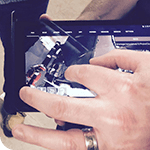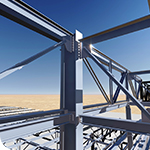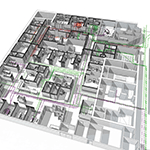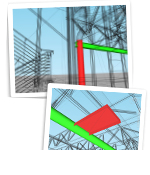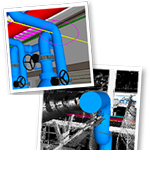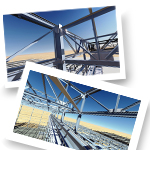The beginning of a new era in construction project delivery.
VDC Steel is an innovative application of SSOE’s virtual design technology that seamlessly integrates steel design, and fabrication, delivering exceptional quality with reduced cost and a compressed schedule.
Virtual Design and Construction is not just a new software or tool—it’s an industry-wide shift in the process for delivering construction projects. In fact, VDC has been compared to the shift that took place when digital cameras were first introduced to the photography industry. With our VDC Steel capabilities, SSOE is well positioned to offer our clients the benefits of this new approach to project delivery since it is in an area where we excel; we have been working with steel structures for 65 years, starting with our first project.
VDC Steel takes a 3D/BIM model beyond design intent and into the design details, shop drawings, fabrication, and procurement. For example, most are familiar with the benefits of clash detection utilizing a 3D model. However, in a VDC application the clash detection is done using the detailed design—exactly as the project is going to be built, not just the design intent. This results in much more powerful and accurate clash detection.
Historically, SSOE has been an industry leader in recognizing the opportunities that result from shedding traditional methods and fully leveraging available technology for the benefit of our clients. This includes our early adoption of 3D / BIM as a tool to reduce inefficiencies and errors in the design process. While BIM has now been widely adopted by both designers and contractors, to-date the intelligence capabilities of the model and efficiencies of utilizing a single model from design through construction have not been fully leveraged. Often, contractors and fabricators must create additional 3D models from the designer’s 2D drawings, which is wasteful and inefficient, and creates more opportunities for errors. VDC is a process change that removes the barriers to using the same intelligent 3D model from design through construction. It reduces the number of handoffs, compresses the schedule, eliminates errors, tightens material quotes, and results in a completed project that is closer to the original design intent. It also improves the ultimate design by revealing issues more generalized drawings miss.
VDC Steel is just one piece of the shift being generated by Virtual Design and Construction. We are excited because it’s a piece our clients can leverage to immediately experience significant benefits.
Benefits of VDC Steel:
Streamlined and seamless integration through one virtual model that produces:
Fabricator ready models
Approved shop drawings
CNC programs
Mill order lists
Exceptional Quality
Advanced clash detection
Limited field errors
Methodical control from design to construction
Reduced Cost
Optimized detailing in a virtual environment
Accurate bids and estimates
Reduction in field change orders
Reduced schedule by a minimum of 4 weeks
Steel lead times Design and approval process
Analysis and options


